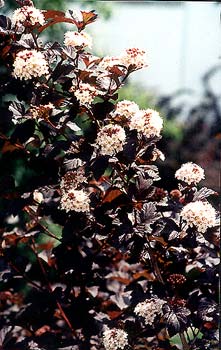 Diablo Ninebark
Diablo Ninebark
"Who's that that rings the bell? Diablo, ho!"
-William Shakespeare
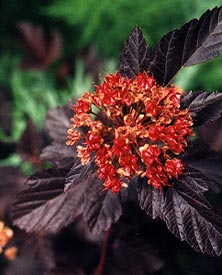 Ninebark (Physocarpus opulifolius) is a thicket-forming deciduous shrub native of North America, ranging from Quebec through the American Northeast & Midwest. Its western counterpart is Physocarpus capitatus which grows along the west coast. Native peoples thought them poisonous or medicinal, the limbs being used to make purgative teas taken internally, or as poultices to treat flaking soars or venereal disease.
Ninebark (Physocarpus opulifolius) is a thicket-forming deciduous shrub native of North America, ranging from Quebec through the American Northeast & Midwest. Its western counterpart is Physocarpus capitatus which grows along the west coast. Native peoples thought them poisonous or medicinal, the limbs being used to make purgative teas taken internally, or as poultices to treat flaking soars or venereal disease.Whether such uses of ninebark are valid has not been adequately studied. It would not be unusual to believe, strictly on the basis of superstition, that a bush with pealing bark would be useful to treat ailments that caused flaking skin conditions. But the genus does in fact have numerous chemical triterpenes in the stem bark. Other plants with triterpenes have been used in China & India to treat dermatological problems.
Left to its own devices Ninebark spreads by underground runners & grows upright & slightly fountaining to eight or even twelve feet. A gardener always has the option of cutting it back to maintain a small extremely compact shrub, as it responds well to even a severe pruning. In the garden its cultivars are not prone to colonizing so are never invasive.
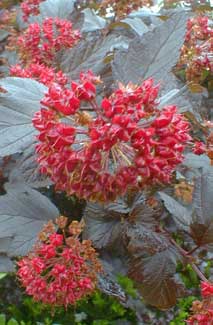 It has several cultivars & the one we have is registered as 'Monlo' though marketed under trademark name "Diabolo" or "Diablo." It is by far the most striking of the different kinds we've seen. It is not as inclined to sucker as the species but gets just as tall.
It has several cultivars & the one we have is registered as 'Monlo' though marketed under trademark name "Diabolo" or "Diablo." It is by far the most striking of the different kinds we've seen. It is not as inclined to sucker as the species but gets just as tall.Our two Diablo ninebarks bloom late May through July, being at their height of flowerfulness in June. The white flowers, as seen in the May's end photo at top, have a faint pinkish cast & occur in two-inch corymbs, a corymb being a fat round snowball made up of tinier blooms.
Regular ninebarks follow the blooms with half-inch green to reddish seeds in summer & autumn, which birds occasionally like to eat. But on the 'Monlo' or "Diablo" cultivar, these seeds are such a bright red, it actually looks like it follows up its white blossoms with bright red blossoms, in clusters two or three inches wide.
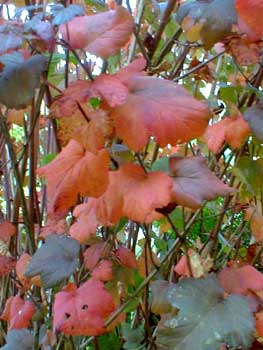 The extremely red seeds against the purple-black leaves are awesomely beautiful, as is obvious from the July (2004) crimson-seed portrait second on this page, & the June (2005) portrait third on the page.
The extremely red seeds against the purple-black leaves are awesomely beautiful, as is obvious from the July (2004) crimson-seed portrait second on this page, & the June (2005) portrait third on the page.After a few weeks these seeds fade to mahagony & are less overt because so close to the color of the leaves, but remain attached to the branches all through autumn, eventually turning nearly black but still well-formed & attractive, still on the branches after leaf-fall.
The most striking of Diablo's many striking features is the deep, dark purple leaves which lend a most distinguished foliage to any garden. Here on Puget Sound the purpleness of the spring leaves lasts through summer & can even darken to nearly black in July. Only in climates hotter & more humid than ours might it fade to a summer green, with only a blush of the spring purple remaining.
Come autumn the leaf color changes first to an almost Halloween-pumpkiny orange as shown in the fourth photo snapped in October (2004), & cuttings are nice to display on the porch with a carved pumpkin.
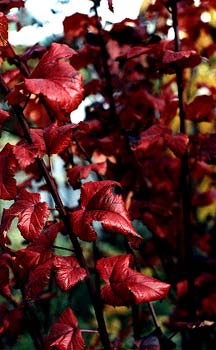 As autumn progresses the leaf color deepens toward a shimmering burgandy-red, as shown in the November portrait (2003) fifth on the page. There are several more portraits of the Fall appearance of the leaves & seedpods on the Diablo Ninebark page of the Autumn Leaves Gallery.
As autumn progresses the leaf color deepens toward a shimmering burgandy-red, as shown in the November portrait (2003) fifth on the page. There are several more portraits of the Fall appearance of the leaves & seedpods on the Diablo Ninebark page of the Autumn Leaves Gallery.The bark of Ninebark is peeling & cracked, quite interesting at close observation. In fact this shrub gets its name from a belief that it has nine layers of bark. Even so, on younger specimens during their first two or three years at least, the overall effect in winter can at times prove to be mediocre & too twiggy, plus it re-leafs relatively late in spring, so that the thin twigginess will not be restored to its fluffy dense foliage for quite a long season.
For this reason some people cut theirs nearly to the ground for the winter, resulting in a compact & bright bush with rapid spring growth, fully fluffed out earlier than if the previous year's limbs were left intact.
But with patience & far less rigorous pruning, it's great to let specimens grow "wild" in order to obtain an impressive height. As the shrub & older stems mature, the exfoliating limbs will eventually gain in character, to become one of the most interesting species for ornamentality in winter.
Because only the previous years' limbs exfoliate, with too regular a pruning schedule, the bark never will get interesting. So I prefer to let it go unpruned or minimally pruned, which results in no lessoning of spring flowering.
Eventually it may seem time to provide the shrub with a freshening hard prune, but I don't feel this should be done even so often as every third year. Ours two shrubs in their fourth year of minimal pruning have remained in top form, & the winter look improves greatly when there are a larger percentage of thickening, aged-looking upright twigs, as can be seen on the Diablo Ninebark page along the Winter Bark Garden Walk.
We have let ours grow as large & bushy as they can get. They get pruned only where branches reach in the way of foot traffic. In their fourth year they reached twelve feet of height in their well-watered locations, & are stunning shrubs.
Ninebark is highly adaptable. It likes best moist well-drained soil in the sun or half sun, but it will tolerate more shade, clay soil, or even drought once established. There are also hardy golden-leafed & dwarf varieties. Even the natural wild form has a good deal in its favor.